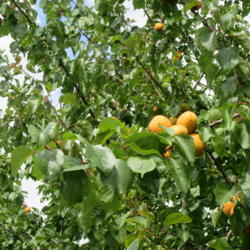
Apricots need water consistently throughout the growing season. Lack of moisture in early summer will result in small fruits; later in the season, it can interfere with bud set for next year's crop. You will probably need to water deeply every 10 to 14 days if there is no rain. Where there is plenty of moisture in the winter and spring, you may need to water only three or four times during the summer. Apply a small amount of nitrogen fertilizer each spring.
Training Young TreesMany growers in western states train young apricot trees to a vase shape (open center). In harsher climates a modified central leader is a better idea. Fruit develops on spurs of 1-year-old branches; the spurs live for 3 or 4 years. Weak branches require thinning or heading to strong lateral branches to encourage new fruiting wood and expose more of the inner parts of the tree to sun and air. Remove fruiting wood that is 6 years old or older. Since apricots bloom very early and many flowers may be killed by frost, wait until after petal fall to prune.
Under good growing conditions trees produce too many fruits. If all the fruits are allowed to stay on the trees, your apricots will be small, and the weight of the fruits could break the branches. Thin out the weakest fruits to the three or four healthiest apricots per cluster. The best time to thin is when fruits measure about 1 inch across. If you have only one or two trees, hand-pick the excess fruits.
Apricot Pests and DiseasesApricots are relatively free of pests and diseases. However, in areas where humidity tends to be high, brown rot disease can pose serious problems. Aside from the plum curculio, the occasional codling moth, and stray peach tree borer, few insects bother these trees. Protect trees from gophers when planting.
HarvestingThe harvest season for apricots is July in mild climates and August in colder ones, though different varieties can be slightly earlier or later. Expect 3 to 4 bushels of fruit from a full-size tree, 1 to 2 from a dwarf. Pick the fruits after they attain a rich apricot color and give slightly when pressed. The apricot season is short, so try to plan around it. If you leave for a 2-week vacation at the crucial time, you may come back to bushels of spoiled fruit on the ground.
 Victory Seed Company has all the seeds you want for your best garden in 2024.
Victory Seed Company has all the seeds you want for your best garden in 2024.
For 25 years, the family-owned Victory Seed Company has provided the highest quality vegetable, herb and flower seeds to families across the country. We are passionate about providing you the best seeds available that give excellent germination, robust plants, and the harvest you want. With a catalog of over a thousand varieties, we have everything, and our prices are the kinds that we'd want to pay. We have hundreds of yesterday's heirloom vegetables, as well as today's award winning hybrid selections. Get to know us by visiting our website and browsing through our online vegetable seed catalog.
| 1. Apricot Essentials |
| 2. Planting Apricots |
| 3. Growing Apricots |
| 4. Care for Apricots ← you're on this article right now |
| 5. Growing Apricots in the North |
| 1. Apricot Essentials |
| 2. Planting Apricots |
| 3. Growing Apricots |
| 4. Care for Apricots ← you're on this article right now |
| 5. Growing Apricots in the North |